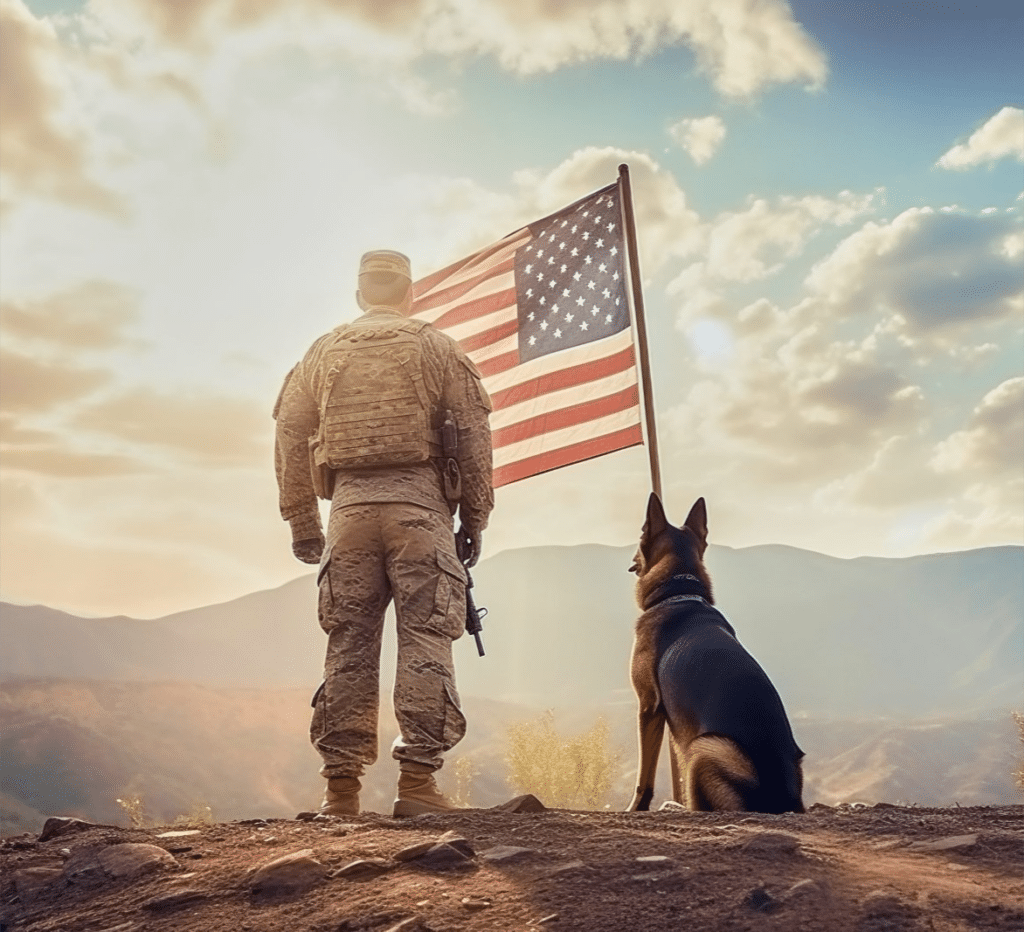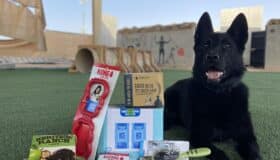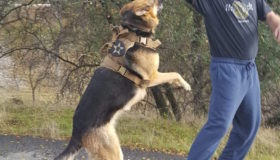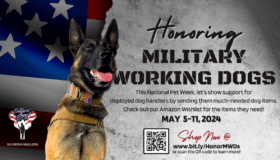DOGS OF DUTY: The Story and Legacy of Military Working Dogs
April 26, 2025
Military Working Dogs (MWDs) have a long and heroic history of serving alongside U.S. military forces. These specially trained K9s are far more than just animals — they are loyal partners in combat, skilled protectors, and lifesaving heroes on the battlefield.
Military Working Dogs: A Legacy of Service and Sacrifice

The history of Military Working Dogs in the United States began on March 13, 1942. That’s when the U.S. Army officially launched its War Dog Program during World War II. The unit later became known as the Army K-9 Corps. This groundbreaking effort was made possible with help from Dogs for Defense — a civilian group that recruited and trained family pets. These dogs were then deployed to serve alongside American troops in combat zones around the world.
These early war dogs were trained for sentry duty, scouting, message delivery, and mine detection. They quickly proved their value by protecting U.S. forces in some of the harshest conditions. The Doberman Pinscher became one of the most iconic breeds of this era. It soon stood as a lasting symbol of courage within the U.S. Marine Corps. Many Dobermans earned military ranks, medals, and the enduring respect of the soldiers they served.
Since their World War II debut, Military Working Dogs have continued to serve on the front lines. They have participated in every major conflict — from Korea and Vietnam to Iraq and Afghanistan. Their roles have expanded dramatically over the decades. With modern MWDs specializing in explosive detection, search and rescue, patrol, and even post-traumatic stress support for Veterans.
These remarkable K9s have earned countless awards for bravery and heroism, often saving lives at great personal risk. But perhaps their greatest legacy is the unbreakable bond they form with their handlers — a partnership built on trust, loyalty, and mutual respect forged in the most challenging environments on earth.
Honoring Loyalty & Sacrifice

At Joint Base San Antonio-Lackland in Texas, two special places stand as powerful tributes dedicated to one of the most loyal and courageous members of the U.S. Armed Forces: The Military Working Dog. For those who want to pay tribute to these four-legged warriors, a visit to the Military Working Dog Teams National Monument and the Security Forces Museum offers an unforgettable and deeply moving experience.
Unveiled in 2013, the Military Working Dog Teams National Monument stands as the first national monument dedicated to dog teams from all branches of the military. Its powerful symbolism and detailed bronze sculptures offer a lasting tribute to every K9 and handler who has served in combat since World War II.
At the heart of the monument stands a nine-foot bronze statue of a modern handler, flanked by four of the most commonly used military dog breeds: the German Shepherd, Belgian Malinois, Labrador Retriever, and Doberman Pinscher. Each sculpture is meticulously crafted to represent strength, vigilance, and loyalty.
Behind them, a granite wall etched with the words “Guardians of America’s Freedom” honors the enduring bond between handler and dog. This is not just a place of remembrance — it is a space for reflection, education, and gratitude.
The monument also includes the “Not Forgotten Fountain,” a touching feature that symbolizes the enduring loyalty of MWDs who have passed.
Just steps away from the monument is the Security Forces Museum, the only museum in the world dedicated solely to the history of the U.S. Air Force Security Forces. Originally established in 1979, the museum chronicles the evolution of the Security Forces from World War II to the present day — and includes a powerful tribute to their canine counterparts.
The MWD exhibit within the museum brings to life the long history of dogs in Air Force operations, from the jungles of Vietnam to the deserts of the Middle East. Visitors can view:
- Real-life stories of MWDs who detected explosives, protected troops, and gave their lives in service.
- Historic photographs, training gear, and deployment equipment used by dog teams.
- Memorial displays honoring handlers and K9s killed in action.
Through these exhibits, guests gain insight into the intense training, deep companionship, and battlefield heroics that define MWD teams.
Together, the Military Working Dog Teams National Monument and the Security Forces Museum offer a profound look into the sacrifice, skill, and heart of America’s K9 warriors. These two sites complement one another beautifully — one offering a national tribute, the other a deep historical perspective.
For Veterans, families, military personnel, and dog lovers alike, a visit to these memorials is a reminder of the silent strength that walks on four legs beside our heroes in uniform.
From Puppy to Protector: America’s K9 Warriors

Today, there are approximately 1,600 Military Working Dogs serving on active duty around the world. Their journey from playful pup to battlefield protector begins at the Department of Defense Military Working Dog Breeding Program, headquartered at Joint Base San Antonio-Lackland in Texas. Each year, this highly specialized program selects 50 to 90 exceptional puppies and begins training them from an early age to join America’s elite K9 military force.
Over the decades, the role of MWDs has expanded significantly. These highly trained dogs serve in countless capacities — from detecting explosives and narcotics to tracking enemy combatants and providing security in hostile environments. Their unmatched senses, courage, and discipline make them invaluable assets to military operations both at home and abroad.
But their most extraordinary gift may lie in something far more personal — their loyalty and bond with handlers. In the most dangerous conditions, these dogs provide protection, companionship, comfort, and trust.
They prove time and again that they are more than just working dogs.
They are true heroes in every sense of the word.
A Story of Loyalty: The Tale of Sergeant Rex

To truly understand the importance of Military Working Dogs, we need look no further than the story of Sergeant Rex.
Sergeant Rex was a German Shepherd who served with the United States Marine Corps. He was trained extensively in explosives detection and was deployed with bravery during a dangerous chapter of the Iraq War.
Alongside his handler, Corporal Megan Leavey, Rex took part in more than 100 missions. He used his sharp instincts to uncover hidden explosives and help protect the lives of countless Service Members.
In 2006, Leavey and Rex were both wounded when an IED exploded during a mission in Iraq. Having faced countless challenges together — from grueling training to life on the battlefield — their connection was unbreakable. Following their recovery, Leavey began a determined and emotional fight to adopt Rex. She shed light on the complicated process many handlers face when trying to bring their retired Military Working Dogs home.
But Leavey’s determination and efforts brought national attention to the cause, and she ultimately reunited with Rex. Their story inspired the 2017 drama film Megan Leavey, which highlights the enduring bond between handlers and their canine partners.
Elite Canine Warriors: Heroes of America’s Special Operations Forces
Cairo and Conan — two elite K9s who served with distinction in the most secretive special operations units in the world: the U.S. Navy SEALs and the U.S. Army’s 1st Special Forces Operational Detachment-Delta (Delta Force). These four-legged warriors are not just remarkable for their skills — they represent the pinnacle of courage, loyalty, and sacrifice.

Cairo, a Belgian Malinois with Navy SEAL Team 6 (DEVGRU), played a critical role in the 2011 raid on Osama bin Laden’s compound during Operation Neptune Spear. Trained in explosives detection and attack tactics, Cairo helped secure the area, locate threats, and protect SEAL operators during the high-risk mission. His bravery highlighted the vital role of Military Working Dogs in special operations. Cairo’s story was later shared by his handler, Will Chesney, in the book No Ordinary Dog.

Eight years after Cairo’s famous mission, another military working dog, Conan, gained worldwide attention. Serving with the U.S. Army’s Delta Force, Conan helped track ISIS leader Abu Bakr al-Baghdadi during a 2019 raid in Syria. When al-Baghdadi tried to escape into a tunnel and detonated a suicide vest, Conan chased him down, preventing his escape. Though injured, Conan survived and recovered. Later, he was recognized as a national hero and was even received at the White House. An honor rarely bestowed upon special operations military working dogs
Cairo and Conan — unsung canine heroes — represent the incredible skill and bravery of military working dogs in special operations. These elite K9s endure intense training to detect explosives, track enemies, and operate in dangerous environments alongside their handlers. Their loyalty and courage make them valued members of their teams. While Cairo and Conan are well-known heroes, many other military working dogs continue to serve in silence, playing critical roles in protecting national security.
More Than Warriors — A Source of Comfort

Beyond their tactical roles, these incredible dogs provide their handlers with something priceless: loyalty and comfort. They also offer emotional support in life’s toughest moments.
The intense environments soldiers face can lead to stress and trauma. The presence of a trusted dog offers comfort, companionship, and a sense of normalcy amid chaos.
Handlers often describe their dogs as their most reliable partners. They are partners who never leave their side, no matter how dangerous the mission.
This bond often lasts long after both human and dog leave the battlefield. Many Veterans credit their canine partners for helping them cope with PTSD and other emotional scars of war.
Soldiers’ Angels MWD Campaign
The Military Working Dog Campaign

In honor of Military Appreciation Month, Soldiers’ Angels is proud to shine a spotlight on some of the most loyal and courageous members of our Armed Forces — Military Working Dogs. Though our Honor Military Working Dogs campaign happens to fall during National Pet Week, we know these remarkable dogs are so much more than pets. They are expertly trained to be deployed alongside our troops, protecting and serving in some of the world’s toughest environments.
From May 4–10, we’re calling on supporters to help us show appreciation for these four-legged heroes by contributing to our Military Working Dog Care Package Collection.
These loyal dogs face challenging conditions while deployed, and a little extra comfort from home can go a long way in boosting their morale.
We’re collecting items such as:
- Durable food and water bowls
- Heavy-duty chew toys
- Grooming tools
- Waste bags
- Other essential supplies to help maintain their strength, health, and readiness in challenging deployment environments.
Want to Help?
This important campaign may come and go in the blink of an eye, but its impact lasts all year long. Visit the Honor Military Working Dogs campaign page to learn more and get started today. With your help, we can make a meaningful difference for Military Working Dogs and their dedicated handlers.
A Legacy That Endures

As military technology advances, the role of the Military Working Dog evolves alongside it. Yet, no matter how advanced our tools become, there will always be a need for the loyalty, bravery, and skill that only a dog can offer.
The story of Sergeant Rex, Cairo, and Conan is just one of thousands that highlight the incredible contributions of MWDs. Behind every mission is a dog who trained tirelessly, faced danger without hesitation, and remained loyal to their handler until the very end.
Military Working Dogs embody the very best of service, sacrifice, and loyalty. They operate in silence, often without recognition, yet their contributions have saved countless lives and shaped the outcomes of critical missions.
Through awareness, advocacy, heartfelt stories like that of Sergeant Rex, Cairo and Conan and campaigns Honoring Military Working Dogs, we can honor these unsung heroes and ensure they receive the care, respect, and love they so richly deserve.
After all, every hero deserves to be honored — especially our four-legged warriors who serve in the defense of our nation.
About the Author

Mike Isaac-Jimenez is a 25-year U.S. Air Force Veteran transitioning into retirement in San Antonio, TX, and currently serving as a SkillBridge intern with Soldiers’ Angels. He holds a B.S. in Technical Management (Project Management) from Embry-Riddle Aeronautical University, along with A.A.S. degrees in Mechanical & Electrical Technology and Mechanical Engineering.


